My experiences on a trip to Angel Falls were different to
those reported in a Globetrotter e-newsletter a couple of months back. I
went in 9/88. The US $ versus Bolivar’s exchange was great. My wife Rosemary
and I flew into Canaima. We had a dugout trip to Orchid Island where we spent
the night. Metal roof, open sides, toilet facilities were any clear spot you
could find in the jungle. It started to rain, they were attempting to roast,
what they called chickens, over an open fire, they were on ironwood stakes.
Unlike any chickens I have ever seen. Eventually they got them halfway
cooked. Not very good. They served an orange juice looking drink. Rosemary
drank it like it was going out of style. She refused to drink the water
because it had been taken out of the river, full of tannin as you are aware,
She didn’t realize that the water in the orange drink was taken out of the
river, nor did I tell her. We slept in the hammocks, no mosquito nets. We
really weren’t bothered with mosquitoes, I don’t understand why.
The next morning they served something for breakfast, not sure what it was, it looked like corn beef hash but it wasn’t. Rosemary said that was enough for her. So she got in an outboard powered canoe with some Indians and went back down river to Canaima where she stayed in the hotel, the only one at that time. I followed instructions and dressed in shorts, BIG MISTAKE. After going up river about an hour I was getting very sun burnt. They found a piece of canvas to put on my legs. They were already burnt, also my face. Best they could find was some sun screen to put on my face. We got to an island where we got out of the canoe. We had to walk part of the way across it as it was too dangerous for us to go thru the falls in a canoe. The Indians walked ahead found a bulldozer and a trailer and came back across the island where we were still walking and picked us up and took us to where the canoes were waiting. We finally about 1430, arrived at the base camp for Angel Falls. All the people walked thru the jungle to base of the Falls. I was unable to do so as I was hurting and lay in a hammock in similar conditions as the night before. When they came back it was getting dusk. They had some people there fixing the meal it was fairly good, the only thing I ate was some sliced pineapple and dank some of the juice. No alcohol allowed but one German had brought a bottle of brandy along and they all enjoyed it. Oldest was about late 30’s I was at the time, 63. One Italian couple had been married three days, another was married eight days. The next morning they took the canoes up river to a point where I could get a good view of the falls.
We all got out and walked around, I didn’t walk much, I was hurting. We went down river to Orchid Island where they were staying the night. Two other canoes were there and leaving for Canaima. One of our Indians, clothed in a loin cloth, went over to one of the canoes and talked to them. The Indian had lived in New York for some years before coming back to Venezuela. He told me to wait until one canoe departed and then for me to go over to the remaining canoe and they would permit me to go with them. He said the first canoe had the operator in it and he would want to charge me a lot of money to go with the canoe. They stopped at a small falls, which was interesting but I didn’t get out of the canoe. We finally made it back to Canaima and walked the mile or so back to where the hotel and other facilities were. I found Rosemary and they took me to an Indian first aid station. The Indian woman there with rings on all her fingers rubbed, what I later found out was Nivea cream into my legs. Those damn rings HURT. Rosemary went to a village store and bought some Nivea cream. That night Rosemary brought a German young couple, back to our room, whom we had met in Merida the week before and I went to the top of Bolivar Mountain, the highest peak in Venezuela. We went up via a four stage cable car. After we got up there I had to be given oxygen. Let me get back to Canaima. I had something to eat at the open air hotel dining facility. The next noon time we stood in line to get on the Avensa Airline 727. There was a large group of Italian tourists there. One young man walked up to near the head of the line when they started loading. The National Guard officer came along and took him to the back to the end of the line. He wasn’t satisfied and when he thought they weren’t looking he went to head of line. Unfortunately for him they were watching. They took him out of the line, stood along side of him and the last we saw of him he was still standing there when the aircraft took off for Caracas.
I went to the medical facility The Dr. there told me I should read: I went to the medical facility where the doctor there told me
Upon arrival In Caracas I decided to go on to Miami, I was hurting. Upon arrival in Miami after a night sleep we started north to Patrick Air Force Base. You might not know where it is but it supports NASA at Cape Canaveral where the shuttles are launched. I went to the medical facility where the doctor there told me, I had a serious burn on the legs and there was a possibility I would need a skin graft. Well I was fortunate I didn’t need it.
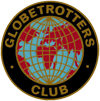
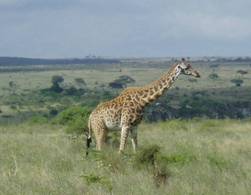
 We got to our destination the Candaba Marsh at dawn, and even before getting
off our van, they told us to spot Egrets flying over and into the distance. How
majestic they looked! Enormous wing span and quite easy to spot due to their
size and number. It was right about there when I was handed a checklist of
the different species of birds we could spot in this particular location. My
eyes widened as I counted 92 listed there! And I was only expecting maybe 2
or 3 species! I couldn’t believe that we had so many different kinds of
birds here in the country! It was also of major interest to me that as one
scientist noted, the Philippines has 80 or so endemic species whereas
countries like the UK had none. All the more curious, I was to find out how
many I’d be able to spot at the end of the day.
We got to our destination the Candaba Marsh at dawn, and even before getting
off our van, they told us to spot Egrets flying over and into the distance. How
majestic they looked! Enormous wing span and quite easy to spot due to their
size and number. It was right about there when I was handed a checklist of
the different species of birds we could spot in this particular location. My
eyes widened as I counted 92 listed there! And I was only expecting maybe 2
or 3 species! I couldn’t believe that we had so many different kinds of
birds here in the country! It was also of major interest to me that as one
scientist noted, the Philippines has 80 or so endemic species whereas
countries like the UK had none. All the more curious, I was to find out how
many I’d be able to spot at the end of the day.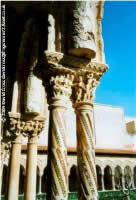 This Duomo must have been quite
remarkable in the twelfth century for the dazzling speed of its construction.
It is believed that it was done and dusted within twelve years. The reason
for this would appear to have been political rivalry between the king and an
archbishop but it does leave us now with a whole building of a single style.
I regarded this visit as being of great historical interest as I had seen
nothing of this type of Greek and Byzantine workmanship, but I did not expect
it to appeal to me artistically. Talk about being bowled over; the impact of
the view of the interior on entry was like a physical blow. Although I have
seen nothing of its type to equal it, it has left me ready to appreciate a
much wider artistic range of church interiors.
This Duomo must have been quite
remarkable in the twelfth century for the dazzling speed of its construction.
It is believed that it was done and dusted within twelve years. The reason
for this would appear to have been political rivalry between the king and an
archbishop but it does leave us now with a whole building of a single style.
I regarded this visit as being of great historical interest as I had seen
nothing of this type of Greek and Byzantine workmanship, but I did not expect
it to appeal to me artistically. Talk about being bowled over; the impact of
the view of the interior on entry was like a physical blow. Although I have
seen nothing of its type to equal it, it has left me ready to appreciate a
much wider artistic range of church interiors.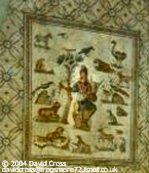 There are some wonderful
mosaics elsewhere in Palermo as well. The church of La Martorana near the
centre has some of these and is probably one of the first things to see in
Palermo. However do not miss seeing the church next to it as well, the little
twelfth century chapel of San Cataldo. This is innocent of mosaics, very
plain in fact, but its very simplicity gives it a considerable appeal.
Strange to English eyes but rather appealing too, are the bright red domes of
the roof. I have more difficulty in writing about the Palazzo dei Normanni,
now the seat of Sicily’s autonomous government. Only a limited amount
can be visited here but this includes the Capella Palatina. Here there are mosaics
which should logically have something of the same effect as those at Monreale.
However for me, although I could appreciate the skill and artistry well
enough, they had no such impact. It was not anti-climax because I saw these
before going out to Monreale. In the Capella I was more fascinated by the
lovely Arabic ceiling. Whilst on the subject of churches I shall mention one
that is no longer consecrated but is a striking building. This is San
Giovanni degli Eremiti, not far from the Piazza del’ Independenza and
the Norman palace. The twelfth century church was built on the remains of an
earlier mosque and it is very much an Arabic type of building, well worth a
visit, although its Christian style cloisters also call. The fact that the
garden is now quite wild seems to enhance rather than detract from the beauty
of the building.
There are some wonderful
mosaics elsewhere in Palermo as well. The church of La Martorana near the
centre has some of these and is probably one of the first things to see in
Palermo. However do not miss seeing the church next to it as well, the little
twelfth century chapel of San Cataldo. This is innocent of mosaics, very
plain in fact, but its very simplicity gives it a considerable appeal.
Strange to English eyes but rather appealing too, are the bright red domes of
the roof. I have more difficulty in writing about the Palazzo dei Normanni,
now the seat of Sicily’s autonomous government. Only a limited amount
can be visited here but this includes the Capella Palatina. Here there are mosaics
which should logically have something of the same effect as those at Monreale.
However for me, although I could appreciate the skill and artistry well
enough, they had no such impact. It was not anti-climax because I saw these
before going out to Monreale. In the Capella I was more fascinated by the
lovely Arabic ceiling. Whilst on the subject of churches I shall mention one
that is no longer consecrated but is a striking building. This is San
Giovanni degli Eremiti, not far from the Piazza del’ Independenza and
the Norman palace. The twelfth century church was built on the remains of an
earlier mosque and it is very much an Arabic type of building, well worth a
visit, although its Christian style cloisters also call. The fact that the
garden is now quite wild seems to enhance rather than detract from the beauty
of the building.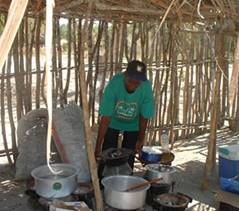 Friday – the shopping trip
to Mtwara took 5 hours whilst Esther searched all over town for
enough chickens to feed this crowd whilst the goat in question was
tethered outside the Boma bleating for a few hours. Saturday –
kitchen a hive of activity chopping, cutting, marinating and
counting bottles of water, soft drinks, plates, glasses, knives,
forks etc. Last minute panic appeared non-existent – my own
memories of the night before a major event of this importance were
very different!
Friday – the shopping trip
to Mtwara took 5 hours whilst Esther searched all over town for
enough chickens to feed this crowd whilst the goat in question was
tethered outside the Boma bleating for a few hours. Saturday –
kitchen a hive of activity chopping, cutting, marinating and
counting bottles of water, soft drinks, plates, glasses, knives,
forks etc. Last minute panic appeared non-existent – my own
memories of the night before a major event of this importance were
very different!
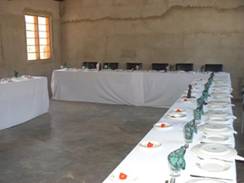 The official party arrived in a flurry of dust as about 40 cars
swept into the school ground. In the background was the celebratory
sound of drums and chanting, and there were dancers that we could
hear but not see from our corner of the school ground. Because they
were so late we abandoned all attempts at ‘silver service’ and put
a couple of desks in the centre of the room as a buffet and allowed
them to help themselves. We were advised to do this so that we
could not be held responsible for delaying them and influencing how
long they took to eat!
The official party arrived in a flurry of dust as about 40 cars
swept into the school ground. In the background was the celebratory
sound of drums and chanting, and there were dancers that we could
hear but not see from our corner of the school ground. Because they
were so late we abandoned all attempts at ‘silver service’ and put
a couple of desks in the centre of the room as a buffet and allowed
them to help themselves. We were advised to do this so that we
could not be held responsible for delaying them and influencing how
long they took to eat!
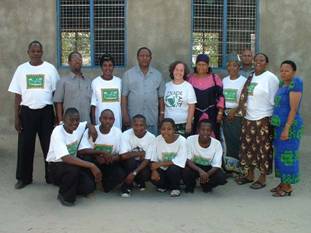 After they had eaten the
District Commissioner invited the whole Boma team into the room,
introduced us and gave a short speech of thanks for providing such
a wonderful lunch. He acknowledged that the Boma is run by Trade
Aid and proceeded to thank Trade Aid for providing this opportunity
for employment and the development of tourism in the Mtwara Region.
The Prime Minister's photographer recorded the event and held a
photo shoot taking a number of pictures on the Trade Aid digital
camera.
After they had eaten the
District Commissioner invited the whole Boma team into the room,
introduced us and gave a short speech of thanks for providing such
a wonderful lunch. He acknowledged that the Boma is run by Trade
Aid and proceeded to thank Trade Aid for providing this opportunity
for employment and the development of tourism in the Mtwara Region.
The Prime Minister's photographer recorded the event and held a
photo shoot taking a number of pictures on the Trade Aid digital
camera.
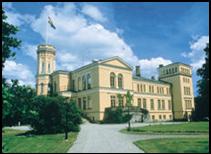 After picking up
our rental car at the airport and after some looking on the map we
found Surahammar Manor. A fantastic place in the Mälar Valley with
romantic surroundings! And such a family atmosphere! The owners
themselves welcomed us and we got a high standard room facing the
parkland. All rooms are individually decorated with elegant
antique furniture. And we really enjoyed the welcome dinner with
Swedish schnapps. In the evening we went early to bed, talked about
our wedding and revelled in that pleasant tired feeling in your
body and serenity in your heart that only a great day can
bring!
After picking up
our rental car at the airport and after some looking on the map we
found Surahammar Manor. A fantastic place in the Mälar Valley with
romantic surroundings! And such a family atmosphere! The owners
themselves welcomed us and we got a high standard room facing the
parkland. All rooms are individually decorated with elegant
antique furniture. And we really enjoyed the welcome dinner with
Swedish schnapps. In the evening we went early to bed, talked about
our wedding and revelled in that pleasant tired feeling in your
body and serenity in your heart that only a great day can
bring!
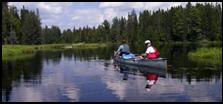 but not. We
were fishing from the Manor’s park! After some hours we had got
four salmon trout and thought it was enough. In the evening we
prepared them together with the cook. Never has a dinner
tasted so good!
but not. We
were fishing from the Manor’s park! After some hours we had got
four salmon trout and thought it was enough. In the evening we
prepared them together with the cook. Never has a dinner
tasted so good!
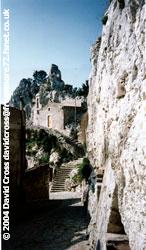 Sciacca is not really on the tourist trail
although it is extremely pleasant and some of the upper town is
really picturesque. There is no really cheap place to stay, though
the Paloma Bianca in Via Figuli was not really dear. The main
appeal of Sciacca for me is the fact that it is an ideal place for
an excellent bus trip to the hill village of Caltabellotta. Sicily
has so much to see [I missed the lovely west coast and most of the
interior, including a terrific Roman villa] that I suspect a lot of
people never make it to any of the smaller towns. Even though I
obviously saw them at the cost of some better known larger places,
Erice in particular, I feel that it is a pity not to sample some
and this is a beaut. From my knowledge of Sicilian hill villages I
would say that somehow they are less picturesque from a distance
but quite as good when inside them as those of the mainland. On the
ride to Caltabellotta it is going up high, rather than heading for
the village, which gives the pleasure and you need to be well up in
the village to see it at its best.
Sciacca is not really on the tourist trail
although it is extremely pleasant and some of the upper town is
really picturesque. There is no really cheap place to stay, though
the Paloma Bianca in Via Figuli was not really dear. The main
appeal of Sciacca for me is the fact that it is an ideal place for
an excellent bus trip to the hill village of Caltabellotta. Sicily
has so much to see [I missed the lovely west coast and most of the
interior, including a terrific Roman villa] that I suspect a lot of
people never make it to any of the smaller towns. Even though I
obviously saw them at the cost of some better known larger places,
Erice in particular, I feel that it is a pity not to sample some
and this is a beaut. From my knowledge of Sicilian hill villages I
would say that somehow they are less picturesque from a distance
but quite as good when inside them as those of the mainland. On the
ride to Caltabellotta it is going up high, rather than heading for
the village, which gives the pleasure and you need to be well up in
the village to see it at its best.
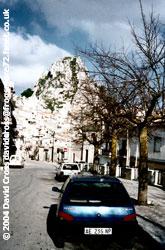 This was only my fifth night out of eleven but already lack of time
was forcing me to adjust my plans. I had meant to go right around
the island anti-clockwise and hopefully to do a trip into the Villa
Imperiale inland. I now realised this was far too much to take on
and I abandoned any notion of reaching the west coast or Segesta, a
spectacular site to the west of the island’s capital, Palermo. This
meant cutting from the south coast to the north at Palermo itself.
I decided on one further southern escapade first – a trip to the
ancient Greek settlement of Selinunte It was necessary to change at
Castelvetrano from the bus bound for Trápani to the local minibus
to Selinunte and the modern village of Marinellla which is little
more than the accommodation for those going to see Selinunte. It
turned out that the wait in this rather ordinary place
[Castelvetrano] was going to be over an hour and a half, and then
when the bus was quarter of an hour late.
This was only my fifth night out of eleven but already lack of time
was forcing me to adjust my plans. I had meant to go right around
the island anti-clockwise and hopefully to do a trip into the Villa
Imperiale inland. I now realised this was far too much to take on
and I abandoned any notion of reaching the west coast or Segesta, a
spectacular site to the west of the island’s capital, Palermo. This
meant cutting from the south coast to the north at Palermo itself.
I decided on one further southern escapade first – a trip to the
ancient Greek settlement of Selinunte It was necessary to change at
Castelvetrano from the bus bound for Trápani to the local minibus
to Selinunte and the modern village of Marinellla which is little
more than the accommodation for those going to see Selinunte. It
turned out that the wait in this rather ordinary place
[Castelvetrano] was going to be over an hour and a half, and then
when the bus was quarter of an hour late.
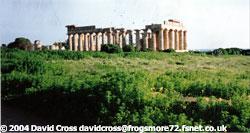 The eastern temples were mainly erected in the sixth century BC and
one of them, Temple E as it rather prosaically named, was
reconstructed in the 1950s. Apparently this was and is
controversial but I feel no qualms about it as long as some are
left as they are found. Whatever, it is a magnificent building and
I am sure a full size re-construction must be the best way of
illustrating to children what these temples were like. The
Acropolis area contains another five temples and most of the
ancient living area as well as the remains of the great walls.
These walls, however, are older than the rest of the remains,
having been built after the city had been destroyed once by
Carthage in order to defend the high ground from further
destructions.
The eastern temples were mainly erected in the sixth century BC and
one of them, Temple E as it rather prosaically named, was
reconstructed in the 1950s. Apparently this was and is
controversial but I feel no qualms about it as long as some are
left as they are found. Whatever, it is a magnificent building and
I am sure a full size re-construction must be the best way of
illustrating to children what these temples were like. The
Acropolis area contains another five temples and most of the
ancient living area as well as the remains of the great walls.
These walls, however, are older than the rest of the remains,
having been built after the city had been destroyed once by
Carthage in order to defend the high ground from further
destructions.
 The name of St Moritz
has an interesting story attached to it: the story told to me was
that Maurice (later turned into Moritz) was a Christian and came
from Egypt. He served in the Roman army under Julius Caesar
and led a Theban legion for the Roman empire and fought in the
Alps. He refused to obey the order of the Emperor Maximian
and sacrifice some Christians to the Roman gods because he was
himself a Christian. On hearing this, Maximian ordered
Maurice's regiment to be decimated – i.e. every tenth person
killed, and this went on until no-one was left. And so
commanding officer Maurice became a saint. Legend has it that
the rock used by Maurice to lay his head on so that he could be
beheaded is at St Moritz. Like England's St George,
St. Maurice is a patron of knights and soldiers. From the
12th century, due the similarity between his name and Maurus, he
was depicted as a Moor, so he became the black saint.
The name of St Moritz
has an interesting story attached to it: the story told to me was
that Maurice (later turned into Moritz) was a Christian and came
from Egypt. He served in the Roman army under Julius Caesar
and led a Theban legion for the Roman empire and fought in the
Alps. He refused to obey the order of the Emperor Maximian
and sacrifice some Christians to the Roman gods because he was
himself a Christian. On hearing this, Maximian ordered
Maurice's regiment to be decimated – i.e. every tenth person
killed, and this went on until no-one was left. And so
commanding officer Maurice became a saint. Legend has it that
the rock used by Maurice to lay his head on so that he could be
beheaded is at St Moritz. Like England's St George,
St. Maurice is a patron of knights and soldiers. From the
12th century, due the similarity between his name and Maurus, he
was depicted as a Moor, so he became the black saint.
 There are lots
of bridges across the River Reuss, it reminded me a little of
Ljubljana, especially with some of the dragon symbols, some of my
friends said Stockholm. One of the most famous is the Chapel
bridge built in the 14th century as a part of the city's
fortifications and named after St. Peter's Chapel, which is
located nearby. It has paintings on it including some info on the
city's patron saints, St. Leodegar and our friend St.
Maurice. There's also a very splendid 17th century
baroque Jesuit church. I really liked the water spikes that
act like a lock to regulate water levels like in a canal. and
you can see the remains of water mills.
There are lots
of bridges across the River Reuss, it reminded me a little of
Ljubljana, especially with some of the dragon symbols, some of my
friends said Stockholm. One of the most famous is the Chapel
bridge built in the 14th century as a part of the city's
fortifications and named after St. Peter's Chapel, which is
located nearby. It has paintings on it including some info on the
city's patron saints, St. Leodegar and our friend St.
Maurice. There's also a very splendid 17th century
baroque Jesuit church. I really liked the water spikes that
act like a lock to regulate water levels like in a canal. and
you can see the remains of water mills.
 On my final day in
Lucerne, I went to the tourist information centre at the train
station and asked where I could go in the mountains. They
suggested a trip to Rigi Kulm, so, using my rail pass, instead of
paying 79 Swiss Francs, it cost me 29 Swiss Francs. It was a
great adventure! I took a boat across Lake Lucerne, and then
a funicular or cog wheel train up the mountain to the top of Rigi
Kulm, about 1,800m, so not too high, and then the cog wheel train
to the half way point and a cable car down to Weggis back down by
the lake, and the boat again back to Lucerne. It was a
wonderful half day trip, where we could see above the clouds, the
mountain tops poking through, then there was the lake and the green
of the alpine pastures leading up to the mountains. There are
a couple of other mountain type trips you can do like this whilst
based in Lucerne.
On my final day in
Lucerne, I went to the tourist information centre at the train
station and asked where I could go in the mountains. They
suggested a trip to Rigi Kulm, so, using my rail pass, instead of
paying 79 Swiss Francs, it cost me 29 Swiss Francs. It was a
great adventure! I took a boat across Lake Lucerne, and then
a funicular or cog wheel train up the mountain to the top of Rigi
Kulm, about 1,800m, so not too high, and then the cog wheel train
to the half way point and a cable car down to Weggis back down by
the lake, and the boat again back to Lucerne. It was a
wonderful half day trip, where we could see above the clouds, the
mountain tops poking through, then there was the lake and the green
of the alpine pastures leading up to the mountains. There are
a couple of other mountain type trips you can do like this whilst
based in Lucerne.